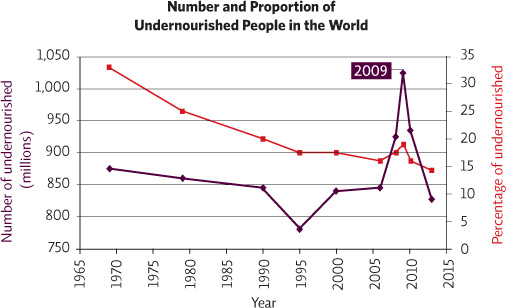SCIENCE LITERACY WORKING WITH DATA
The Food and Agriculture Organization (FAO) of the United Nations monitors world hunger and has set a goal of decreasing the percentage of underfed people to 10% of the world’s population by 2015.

Interpretation
1. Describe in one sentence what the graph shows about change in undernourishment over time. Why are both lines shown here?
Both the percentage and the sheer number of undernourished people dropped slightly between 1970 and 2005 but both—especially the number of undernourished people—rose sharply between 2005 and 2009. The line showing percentage of undernourished people gives us an idea of how population growth itself might have contributed to any rise that was observed. If the number of undernourished people increased but the percentage did not, this could merely reflect the fact that there were more mouths to feed as population grew. If the percentage of undernourished people dropped, even if sheer numbers increased or dropped more slowly, it could indicate that some progress was being made—more individuals were being fed.
2. What accounted for the decline in the number and proportion of undernourished people from 1970 to 2000?
The decline seen between 1970 and 2000 was probably due to the Green Revolution producing more food. It was able to produce enough food to decrease the number and percentage of people who were undernourished even as world population grew rapidly at this time.
3. What happened to the percentage of underfed people between 2008 and 2009? What do you think led to this change?
The percentage increased—more people were underfed. This could reflect economic and food scarcity problems that drove up the price of food beyond what people in low-income areas could afford.
Advance Your Thinking
4. Do you think the FAO will meet its goal of halving the percentage of underfed people from 1992 to 2015, from 20% to 10%? Why or why not?
It doesn’t seem likely that FAO will reach this goal, due to the combination of the very slow trend in decreasing the percentage of hungry people, the possibility of future world food crises, and an increasing number of people being born into the world.
5. In looking at both the number and percentage of underfed people, do you think there has been a complete recovery from the 2008 world food crisis? Why or why not?
Based on just the number of undernourished people, there does not seem to be a complete recovery from the 2008 world food crisis because the number undernourished in 2010 is still far more than were undernourished in 2005. However, the percentage values show that the percentage who were undernourished in 2010 was back to the pre-crisis value of about 16%. So, while the population is still growing, the percentage of undernourished people is about the same as it was before the crisis; thus we may be close to recovery.
6. Extrapolate these lines into the future, based on whether the Gene Revolution is successful and whether it is not. Which scenario do you think is more likely? Explain your reasoning.
If the Gene Revolution is successful, we may see another steep drop like we saw in the 1970s after the Green Revolution. This would bring us to the 10% FAO target around 2020, assuming population growth continues to slow. If the Gene Revolution does not work, the percent of undernourished people may begin to rise again as population rises if other methods to increase food production and availability are not found.
The second part of the question is an opinion and answers may vary. Positions should be supported with evidence.